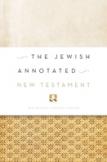Root Study
Among the major developments in biblical scholarship and church life in recent decades has been the accumulation of a treasury of accurate knowledge of the world of first-century Judaism, which gave birth to the New Testament. Once this world was described mainly by contrasting a stereotypical legalistic and narrow-minded Judaism to a Christian Gospel of graced freedom. Now there exists a substantial collection of studies by Jewish and Christian scholars that we can hope has eradicated this way of thinking.
Ten years in the making, The Jewish Annotated New Testament is a monument to past achievements in New Testament scholarship and a beacon for future study. While Christian scholars have written major commentaries on the Old Testament, better described as the Tanakh by Jewish scholars, this work is the first major commentary on the New Testament entirely by Jewish scholars. The modest title scarcely conveys the quality of scholarship packed into its 637 pages. The authors are really a Who’s Who of Jewish experts on Second Temple Judaism who have educated a generation of Christian scholars. Adopting the New Revised Standard Version as its text and following a pattern found in works like the Catholic Study Bible and the Oxford Annotated Bible, after a brief introduction of standard information on authorship, date and structure, explanatory notes are offered on every chapter of every book.
The work itself is both a model one-volume commentary on the individual books of the New Testament and a compendium of necessary information for engaged reading and study by scholar and student alike. The collection of maps, charts and diagrams, along with the short sidebar essays, are guiding lights throughout the volume, which contain a fund of information that leads readers to a rich understanding of texts in their literary and historical context. Unique to this work is its demonstration of how utterly Jewish are the writings of the New Testament, not only in relation to their Old Testament heritage but also to the faith and culture of their origin. A major contribution of this work are the notes that list close similarities between New Testament statements and the writings of post-biblical Judaism, especially the Mishnah and Talmud (described in a helpful glossary).
The editors, who deserve our lasting gratitude, describe the two-fold purpose of this book. The first is to invite Jewish readers to see the New Testament as a way of understanding their own religious heritage. This is itself a tribute to the growth in understanding between Jews and Christians over the past decades. The New Testament for the most part contains writings by Jews and for Jews who accepted Jesus as a Jewish prophet and a messiah. Jewish readers will find significant information on first century Jewish practice, beliefs and lives of ordinary people, including monotheistic faith at the center of life, cycle of festivals and religious groups, along with insight into the social and economic context of first-century Judaism.
But Christians, the second intended category of readers, may benefit most. The 18 extended essays that follow the commentaries could qualify as an independent collection and are themselves, to use a commonplace, “worth the price of the book.” I would highlight the initial essay by Amy-Jill Levine, “Bearing False Witness: Common Errors Made About Early Judaism”; I recommend that it be read first. While others will have their favorites I found especially helpful the essays “The Law,” “Jewish Movements of the New Testament Period,” “Messianic Movements,” “The Concept of Neighbor in Jewish and Christian Ethics” and “Afterlife and Resurrection.”
The authors face squarely the lethal effect of such texts as the cry of the crowd, “His blood be upon us and our children” (Mt 27:25), which have poisoned attitudes toward Judaism over the centuries but which Aaron Gale locates in their historical context. Of Mt 27:25 he writes, “Matthew’s first readers likely related the verse to the Jerusalem devastation in 70 C.E.”
Of particular value is the superb commentary on the Gospel of John by Adele Reinhartz, of the University of Ottawa. Her introduction offers an eloquent epitome of this Gospel: “The Gospel according to John...is one of paradox and contradictions both in its content and in the reactions it evokes in its readers. It presents a sublime vision of a future salvation that is also in some inexplicable way already a present reality.”
Along with this praise and appreciation Reinhartz confronts honestly the sectarian quality of John and its at times venomous comments on the Jews. She faces directly the destructive power and use of, for example, John 8:44: “You are from your father the devil, and you choose to do your father’s desires,” which “has fueled anti-Judaism and anti-Semitism from ancient times to the present day.” But she notes that this is a text that must be read in the context of John’s dualism, which “contrasts spirit and flesh, light and darkness, life and death...belief and unbelief,” and further notes that this language is part of a process of self-definition as John’s community distinguishes itself “from the synagogue and so from the Jews.”
As Catholics celebrate the 50th anniversary of the Second Vatican Council, we realize that The Jewish Annotated New Testament bears the legacy of two historic conciliar documents, the “Dogmatic Constitution on Divine Revelation,” with its affirmation of the historical critical method, and the historic “Declaration on the Relation of the Church to Non-Christian Religions,” which Cardinal Kurt Koch, president of the Pontifical Council for Promoting Christian Unity, recently highlighted as a “yes to our Jewish roots; no to anti-Semitism.”
The Annotated Jewish New Testament should be either a primary text or required accompanying work in every seminary and upper-division course in New Testament and should leave its mark on all preaching.
This article also appeared in print, under the headline “Root Study,” in the August 27, 2012, issue.








